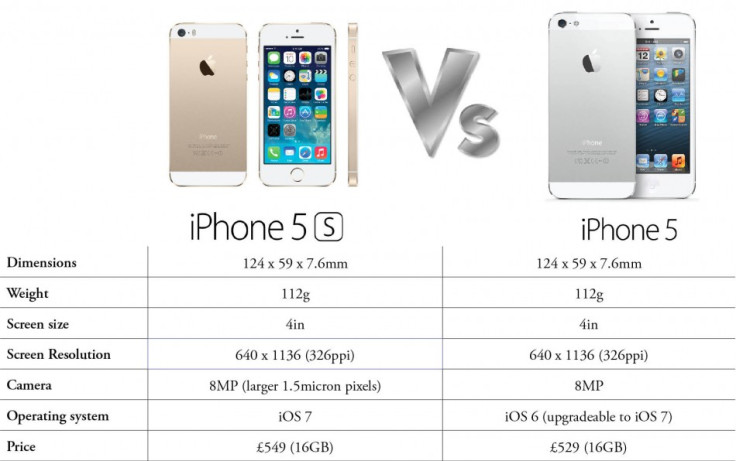iPhone 5S vs iPhone 5 - Should I Upgrade? [VIDEO]

Apple has updated its flagship smartphone, the iPhone 5, one year after it went on sale, bringing a faster processor, a 'champagne' colour option, and an integrated fingerprint reader - but are these updates enough to consider upgrading to the iPhone 5S?
Hardware
Little has changed on the outside, other than the additional of a fingerprint scanner to the Home button, a larger dual-flash for the rear camera, and that new gold/champagne colour option. Safe to say, all but the most knowledgable Apple fan would struggle to tell the iPhone 5 and 5S apart.
Embedded in the phone's home button, the fingerprint scanner is a first for an Apple product and makes unlocking the device easier than before - no need to enter a PIN or password, just press your thumb against the reader and the phone will unlock.
The reader can also be used as a shortcut to entering passwords, such as when buying content from the iTunes Store.
4G on all networks
Inside, Apple has made a key change to the iPhone's antennas used for connecting to mobile networks. The year-old iPhone 5 does not work with the new 4G networks launch by O2 and Vodafone last month, as they use a different radio band to EE, which switched on its iPhone 5-compatible network a year ago. With upgraded antennas in place,the iPhone 5S will work on 4G services from all UK networks, as well as many others abroad.
Around the back, Apple has improved the iPhone's camera by including a second flash and wider f/2.2 aperture lens for improved low-light performance - further boosting low light performancer is an image sensor that is 15% bigger than that in the iPhone 5.
The iPhone 5S can shoot 1080p HD video, and include support for 720p HD video recording at 120 frames per second, four times the speed of the iPhone 5, producing smoother video which can be used to create slow-motion footage.
Following HTC's lead, Apple has given the 5S's camera a sensor with larger pixels to capture more light, improving photo quality - especially at night. There's also auto image stabilisation and improvements to the camera's ability to auto-focus on a subject.
Performance
As is customary, Apple used the new iPhone launch to reveal its latest mobile system-on-a-chip, the A7. Although claimed to be five times faster overall than the year-old A6, Apple never quotes the speed or number of cores of its mobile processors, so we'll have to wait for third-party tests to learn exactly how much faster the iPhone 5S is.
The A7 processor is 64-bit, a first for any smartphone, and is said to be "up to twice as fast" as the iPhone 5's A6 chip, with speed gains for both computing and graphical performance. Compared to the original 2007 iPhone, the 5S boots up 42 times faster, and graphics are now up to 56 times faster than the first generation iPhone.
Joining the A7 is a new M7 chip - M standing for motion coprocessor - which is responsible for continually tracking motion data, which can be used by applications such as Nike+ to create a new range of fitness tracking apps.

Software
The iPhone 5S ushers in iOS 7 to the general public, but the all-new operating system will also be made available to iPhone 4, 4S and 5 owners. Functions on older models will be limited; for more information, read our iOS 7 device compatibility guide.
Price
The iPhone 5S is slightly more expensive than the outgoing 5, priced at £549 for the 16GB model £629 for 32GB and £709 for the range-topping 64GB model. By comparison, the iPhone 5 started at £529 for the 16GB version.
Should I upgrade?
As with all S iterations, the iPhone 5S take a very good phone and makes it slightly better. Yes, the gold colour option may appeal to some but really the biggest features here are extra 4G support and the fingerprint scanner - and even that is something of a novelty, until applications develops can come up with useful functions for it, such as speeding up online purchases or money transfers.
Extra performance is always welcome, but bumps in RAM and processor speed have become less important as the playing field for high-end smartphones has been all but levelled over the last 12 months - we suspect you'd be hard pressed to notice a helpful increase in performance from 5 to 5S, at least until more demanding games and apps are made to utilise the extra power.
If you can afford the update then sure, why not, but for many users we imagine the jump to iOS 7 will feel like moving to a new phone anyway - and for those who don't own an iPhone 5, keep an eye out for the newly announced iPhone 5C, which starts at £469 for the 16GB model, or even a new 8GB version of the iPhone 4S, priced at £349.
© Copyright IBTimes 2025. All rights reserved.






















